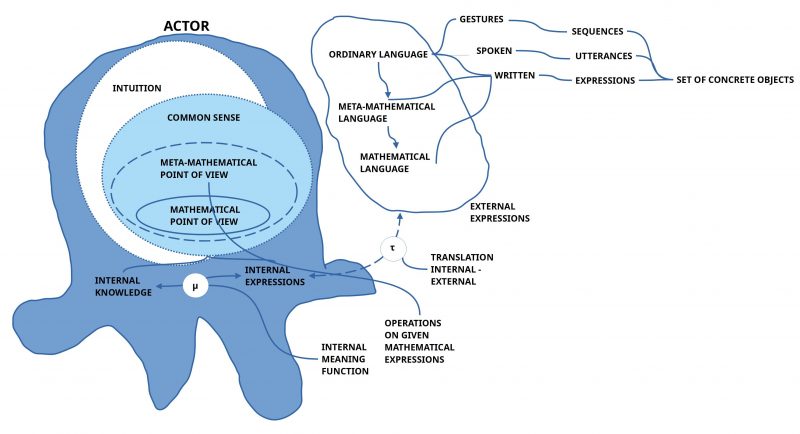eJournal: uffmm.org, ISSN 2567-6458, Sept 29, 2021 – Sept 29, 2021
Email: info@uffmm.org
Author: Gerd Doeben-Henisch
Email: gerd@doeben-henisch.de
SCOPE
In the uffmm review section the different papers and books are discussed from the point of view of the oksimo paradigm. [1] In this text the author reads the book “Rise of the machines. A cybernetics History.” by Thomas Rid, 2016. [2],[3]
OUTLINE OF SOME IDEAS
General
The book has received a lot of high-ranking comments which are strongly positive. The reviewer can confirm such positive comments: the book takes the reader to a fascinating journey of ideas, historical settings, exciting personalities, and reveals the shape of a ‘hidden logic’ behind the development of ideas, technologies and societal processes associated with the topic ‘cybernetics’.
Having read the book it is and exciting endeavor to locate the ideas of the book in a different setting of ideas, history and societal aspects. This will not discredit the book, but it will — perhaps — ‘inspire‘ some more ‘myth’, which can help us to integrate a bit more the the ‘real cybernetics’ of biological life, which is practicing the principle of cybernetics since its start on the planet earth some 3.5 Billion years ago, while the additional features of the technological offspring have shown up only recently.
CYBERNETICS
In his preface Thomas Rid challenges the reader with the presentation of a manifold of perspectives all associated with the word ‘cybernetics’ and its short accelerator ‘cyber-X’; this ‘X’ can stand for ‘-war’, ‘-security’, ‘-suite’, ‘-punk’, ‘-space’, ‘-sex’, and even more.
While especially two books Cybernetics (1948)[5b] and Neuromancer (1984) [4b] seem to have a major influence for the ‘myth’ of cybernetics, Rid points out in his book that there is a much broader stream of events, facts, and persons contributing to the real story as well as to the ‘myth’ of cybernetics.
His way to deal with the term/ word ‘myth’ is especially fascinating. While we since about the last 150 years have been culturally be trained in a kind of ‘fact-thinking’, using formal languages and formal models, the main history of humans as homo sapiens was always characterized by telling stories and thereby creating ‘pictures of the world’: how do all the different aspects of life ‘work together’. From a scientifically trained mind this long tradition can look perhaps a bit ‘outdated’, but as modern philosophy of science can show, such a negative reception is a strongly misleading understanding of the role of ‘stories’, the role of ‘myths’: scientific fine-graded knowledge is partially possible and necessary, but it can only work by presupposing a ‘normal’ language and presupposing a ‘normal’ common sense. Faced with an overwhelming complexity of the real live even science has to use ‘pictures’ like ‘myths’ to communicate an ‘assumed whole’ which is not — and never — completely be describable in a complete formal model.
This cultural important role of a ‘myth’ is accepted by Rid because without the concept of a ‘myth’ it is not really possible to describe the societal phenomenon of ‘cybernetics’ with all its features. For Rid myths “overcome the limits of facts…” (p.xiv), are “remarkable … for their form”(p.xiv), they “transcend the present”.(p.xv) And indeed, if one follows the text of Rid it gives you a taste of the powerful role of the modern myth about ‘cybernetics’ where so many different perspectives are constantly interacting. Even the engineers, the military leaders, and the scientists too are embedding their real doings in the more broader ‘myth’ of cybernetics which makes cybernetics thereby to a broad cultural phenomenon.
And it is exactly this ‘all-embracing character’ of the cybernetics myth which makes the phenomenon ‘strong’ but at the same time also ‘vulnerable’: the cybernetics myth presupposes and includes many hidden ideas and assumptions which possibly are not optimal or even wrong. It is this implicit vulnerability of a myth which calls for an ongoing ‘work on the myth’.[6a], [6b]
To be continued …
COMMENTS
[1] Gerd Doeben-Henisch, 2021, uffmm.org, THE OKSIMO PARADIGM
An Introduction (Version 2), https://www.uffmm.org/wp-content/uploads/2021/03/oksimo-v1-part1-v2.pdf For more information you can visit the German blog oksimo.org, which has more and more recent information. Until not these texts are only in German on account of lack of resources to translate them.
[2] Thomas Rid (2016), Rise of the machines. A cybernetics History. W.W.Norton & Company, Independent Publishers Since 1923 (New York – London). /* The German edition: maschinen dämmerung. eine kurze geschichte der kybernetik published 2016 by the Publisher Propyläen, owned by Ullstein Buchverlag GmbH (Berlin) */
[3] Homepage of Thomas Rid: https://ridt.co/
[4a] William Ford Gibson: Wikipedia EN: https://en.wikipedia.org/wiki/William_Gibson
[4b] Willimam F. Gibson (1984), Neuromancer. see: https://en.wikipedia.org/wiki/Neuromancer
[5a] Norbert Wiener (1894 – 1964): Wikipedia EN: https://en.wikipedia.org/wiki/Norbert_Wiener
[5b] Norbert Wiener (1948), Cybernetics: Or Control and Communication in the Animal and the Machine, see: https://en.wikipedia.org/wiki/Cybernetics:_Or_Control_and_Communication_in_the_Animal_and_the_Machine
[5c] Norbert Wiener (1950), The Human Use of Human Beings, see: https://en.wikipedia.org/wiki/The_Human_Use_of_Human_Beings
[6a] Thomas Rid explicitly mentions the German Philosopher Hans Blumenberg [6b] who is well known for his work investigating and reflecting the role of ‘myth’ in culture. And in this context Blumenberg points out the vital role of ‘myth’ which — as attitude of ‘survival’ — has to modify itself constantly, to adapt the different unproved assumptions to a more convincing overall picture.
[6b] Hans Blumenberg (1920 – 1996), see: https://en.wikipedia.org/wiki/Hans_Blumenberg

